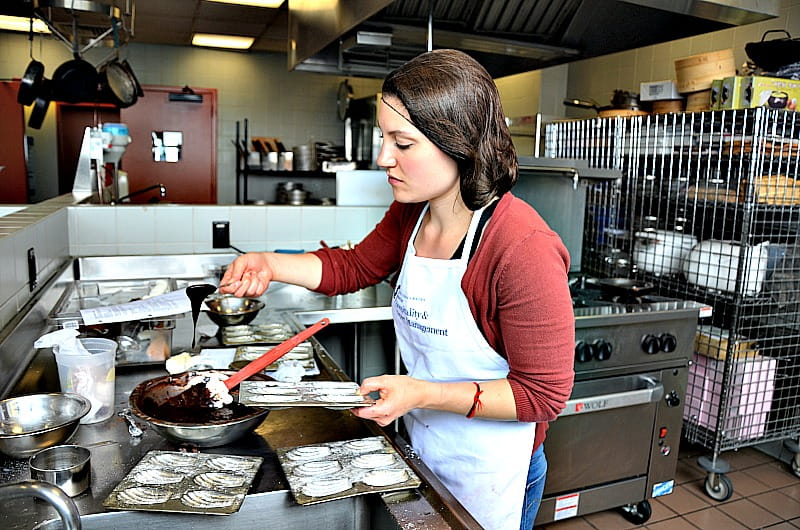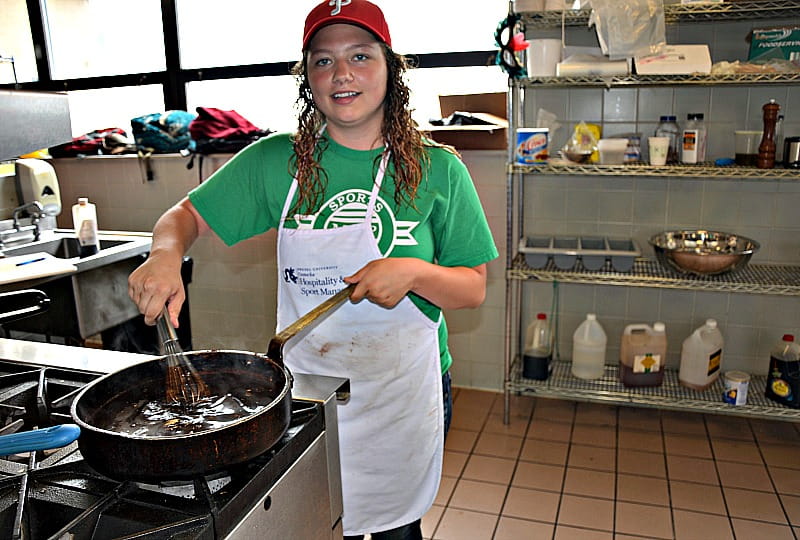Honors Students Whip Up Film-Worthy Feasts

- Ribbon-Cutting Ceremony Marks Official Unveiling of Drexel Station at 30th Street
- Drexel’s Pearlstein Gallery Offers Spring Exhibitions Centered on the Healing Properties of Art and Creative Works
- Express Your Thoughts About Climate Change in the Anthems for the Anthropocene Contest
- 40 Years Ago, Drexel Made Computer — and Apple — History

Students from Drexel’s Pennoni Honors College have been indulging in movies good enough to eat — literally.
For the first time, a class of non-culinary arts students are recreating dishes from food-centric films they had previously watched and analyzed. In the honors course “Food in the Arts: Film,” the students cook different types of cuisines while divulging in the historical and cultural aspects of each film’s setting.
Over the course of spring term, students have indulged in sweet and savory chocolate dishes from the romantic comedy “Chocolat,” succulent French cuisine from “Babette’s Feast” and “Vatel,” and noodles and Japanese cuisine from the “ramen western” “Tampopo.”
“All students are in the honors program and are non-culinary majors,” said Edward Bottone, chef and assistant teaching professor in the culinary arts and food science program in the center for Hospitality and Sport Management. “Some students have little cooking skills. Others have a keen interest in cooking. Remarkably, the food turns out delicious.”
Bottone designed the course to be a blend of film studies and culinary arts. After watching each film, the students discuss the movie, read scholarly articles and write analytical papers — and cook the food they’ve studied, of course.

“At the surface, the class has a lot of applicable things to life. There’s the analysis of film, but then you try and make the movie come alive,” Melissa Trofa, a sophomore finance and business analytics major, said while preparing a chocolate chili molé glaze for a turkey dish during the “Chocolat” cooking class.
Having taught the class within the culinary arts program in the Center for Hospitality and Sport Management, Bottone curated each film to represent an aspect of the food industry, such as historical or cultural trends and the roles of chefs at the time.
“The first film, ‘Who is Killing the Great Chefs of Europe?,’ shows Italian and French cooking—continental cuisines,” Bottone said. “It was made in the 1970s, but it really holds up well. It deals with social issues, the rise of food magazines, chef rivalries and gender relations. That sets the students up for everything else in the class.”
From 1970s Europe, the students cooked their way through a 17th century French château in “Vatel,” roadside noodle stands in Japan for ‘Tampopo,” and conservative villages in 1950s France and 19th century Denmark for “Chocolat” and “Babette’s Feast,” respectively. As varied as the cuisines and times are, each film relates to the other through a shared, overarching theme.
“In every movie, there’s a stranger who comes to town, and they transform the town by food,” said Bottone. “It’s Louis XIV in ‘Vatel’ visiting a small French town in 17th century France and the chef, played by Gerard Depardieu, has to oversee everything, including the entertainment. Or in ‘Chocolat,’ it’s a single mother arriving in town to set up a chocolate store in a strict French village just before Lent.”
The class has been a recipe for success for students of all majors and cooking skill levels who have witnessed the powers of food in films and in the kitchen.

“It’s a great break from my regular course load. This was the first Honors course I chose,” Zachary Gibbons, a freshman chemical engineering major, explained as he prepared a layered chocolate cake with a chocolate glaze inspired by, you guessed it, ‘Chocolat.’
According to Bottone, “Food in the Arts: Film” ‘sold out’ within hours of the opening ticket. It was a repeat of when the first class in Bottone’s trilogy of “Food in the Arts” courses, “Food in the Arts: Literature,” was offered during the winter term. The
literature-based offering gave students the chance to read and cook from food novels, like ‘The Hundred Foot Journey.”
Now, Bottone is working on an arts-based “Food in the Arts” class in which students would learn and bring to life work from the many artists who have depicted food, from Cezanne’s Impressionist apples to Wayne Thiebaud’s pop art pastries and ice cream cones.
Based on the student reception of the first two course’s offerings, that would make for quite the feast.
In This Article
Drexel News is produced by
University Marketing and Communications.
